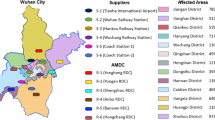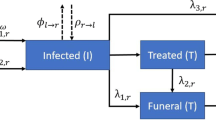Abstract
This paper presents a dynamic logistics model for medical resources allocation that can be used to control an epidemic diffusion. It couples a forecasting mechanism, constructed for the demand of a medicine in the course of such epidemic diffusion, and a logistics planning system to satisfy the forecasted demand and minimize the total cost. The forecasting mechanism is a time discretized version of the Susceptible-Exposed-Infected-Recovered model that is widely employed in predicting the trajectory of an epidemic diffusion. The logistics planning system is formulated as a mixed 0–1 integer programming problem characterizing the decision making at various levels of hospitals, distribution centers, pharmaceutical plants, and the transportation in between them. The model is built as a closed-loop cycle, comprising forecast phase, planning phase, execution phase, and adjustment phase. The parameters of the forecast mechanism are adjusted in reflection of the real data collected in the execution phase by solving a quadratic programming problem. A numerical example is presented to verify efficiency of the model.






Similar content being viewed by others
References
Aiello OE and Silva MA (2003). New approach to dynamical Monte Carlo methods: Application to an epidemic model. Physica A: Statistical Mechanics and its Applications 327 (3): 525–534.
Arenas AJ, González-Parra G and Chen-Charpentier BM (2009). Dynamical analysis of the transmission of seasonal diseases using the differential transformation method. Mathematical and Computer Modelling 50 (5–6): 765–776.
Arenas AJ, González-Parra G and Chen-Charpentier BM (2010). A nonstandard numerical scheme of predictor—Corrector type for epidemic models. Computers & Mathematics with Applications 59 (12): 3740–3749.
Brandeau ML, Sainfort F and Pierskalla WP (2004). Operations Research and Health Care. Kluwer Academic Publishers: Boston.
Brandeau ML, Zaric GS and Richter A (2003). Resource allocation for control of infectious diseases in multiple independent populations: Beyond cost-effectiveness analysis. Journal of Health Economics 22 (4): 575–598.
Dasaklis TK, Pappis CP and Rachaniotis NP (2012). Epidemics control and logistics operations: A review. International Journal of Production Economics 139 (2): 393–410.
Dimitrov NB and Meyers LA (2010). Mathematical approaches to infectious disease prediction and control. Faculty Publications 7 (4): 26–27.
Duintjer Tebbens RJ, Pallansch MA, Alexander JP and Thompson KM (2010). Optimal vaccine stockpile design for an eradicated disease: Application to polio. Vaccine 28 (26): 4312–4327.
Ekici A, Keskinocak P and Swann JL (2014). Modeling influenza pandemic and planning food distribution. Manufacturing & Service Operations Management 16 (1): 11–27.
Hanke JE and Wichern DW (2009). Business Forecasting. 9th edn, Pearson/Prentice Hall: Upper Saddle River, NJ.
Kar TK and Batabyals A (2011). Stability analysis and optimal control of an SIR epidemic model with vaccination. Biosystems 104 (2–3): 127–135.
Kim KI, Lin ZG and Zhang L (2010). Avian-human influenza epidemic model with diffusion. Nonlinear Analysis: Real World Applications 11 (1): 313–322.
Liu JL and Zhang TL (2011). Epidemic spreading of an SEIRS model in scale-free networks. Communications in Nonlinear Science and Numerical Simulation 16 (8): 3375–3384.
Liu M, Zhang Z and Zhang D (2015). A dynamic allocation model for medical resources in the control of influenza diffusion. Journal of Systems Science and Systems Engineering 24 (3): 276–292.
Mishra BK and Saini DK (2007). SEIRS epidemic model with delay for transmission of malicious objects in computer network. Applied Mathematics and Computation 188 (2): 1476–1482.
Qiang Q and Nagurney A (2010). A bi-criteria measure to assess supply chain network performance for critical needs under capacity and demand disruptions. Transportation Research Part A 46 (5): 801–812.
Rachaniotis NP, Dasaklis TK and Pappis CP (2012). A deterministic resource scheduling model in epidemic control: A case study. European Journal of Operational Research 216 (1): 225–231.
Rottkemper B, Fischer K and Blecken A (2012). A transshipment model for distribution and inventory relocation under uncertainty in humanitarian operations. Socio-Economic Planning Sciences 46 (1): 98–109.
Samsuzzoha M, Singh M and Lucy D (2010). Numerical study of an influenza epidemic model with diffusion. Applied Mathematics and Computation 217 (7): 3461–3479.
Samsuzzoha M, Singh M and Lucy D (2012). A numerical study on an influenza epidemic model with vaccination and diffusion. Applied Mathematics and Computation 219 (1): 122–141.
Sun CJ and Hsieh YH (2010). Global analysis of an SEIR model with varying population size and vaccination. Applied Mathematical Modelling 34 (10): 2685–2697.
WHO (2015). HIV/AIDS, http://www.who.int/features/qa/71/en/, accessed 8 October 2015.
Yan SY, Lin CK and Chen SY (2014). Logistical support scheduling under stochastic travel times given an emergency repair work schedule. Computers & Industrial Engineering 67 (1): 20–35.
Yi N, Zhang QL, Mao K, Yang DM and Li Q (2009). Analysis and control of an SEIR epidemic system with nonlinear transmission rate. Mathematical and Computer Modelling 50 (9–10): 1498–1513.
Zaric GS and Brandeau ML (2001). Resource allocation for epidemic control over short time horizons. Mathematical Biosciences 171 (1): 33–58.
Zaric GS and Brandeau ML (2002). Dynamic resource allocation for epidemic control in multiple populations. Journal of Mathematics Applied in Medicine and Biology 19 (4): 235–255.
Zaric GS, Bravata DM, Cleophas Holty JE, McDonald KM, Owens DK and Brandeau ML (2008). Modeling the logistics of response to anthrax bioterrorism. Medical Decision Making 28 (3): 332–350.
Zhang J, Li JQ and Ma ZE (2006). Global dynamics of an SEIR epidemic model with immigration of different compartments. Acta Mathematica Scientia 26 (3): 551–567.
Zhang J and Ma ZE (2003). Global dynamics of an SEIR epidemic model with saturating contact rate. Mathematical Biosciences 185 (1): 15–32.
Acknowledgements
The authors would like to thank the three anonymous referees for their valuable comments that have helped to improve the quality of the paper. This work has been partially supported by the National Natural Science Foundation of China (No.71301076, 71401075), Natural Science Foundation of Jiangsu Province (BK20130771) and the Research Fund for the Doctoral Program of Higher Education of China (20133219120037).The second author gratefully acknowledges the Zi** Chair Professorship that supported his visit to the Nan**g University of Science and Technology during his sabbatical leave while this work was conducted.
Author information
Authors and Affiliations
Corresponding author
Rights and permissions
About this article
Cite this article
Liu, M., Zhang, D. A dynamic logistics model for medical resources allocation in an epidemic control with demand forecast updating. J Oper Res Soc 67, 841–852 (2016). https://doi.org/10.1057/jors.2015.105
Received:
Accepted:
Published:
Issue Date:
DOI: https://doi.org/10.1057/jors.2015.105




